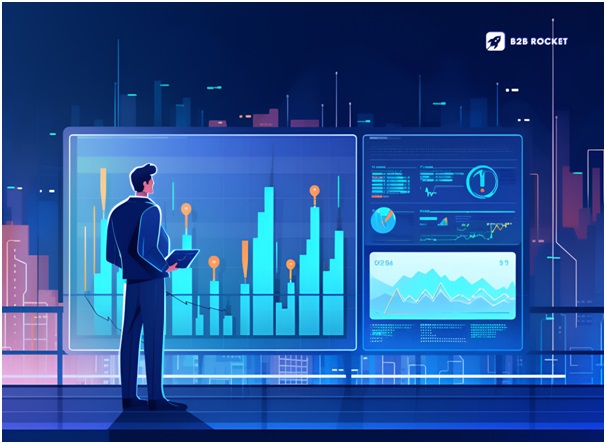
AI-Enhanced Customer Segmentation in B2B: Maximising ROI
AI is an intelligent instrument capable of analysing vast amounts of data and identifying useful trends. Using AI to categorise B2B customers helps improve profits and financial success.
We will first discuss why grouping customers is important for B2B. Then, we’ll explain how AI makes this easier. We’ll also give you steps to use AI for grouping customers and see how it affects how much money you make. Additionally, we’ll recount actual narratives of companies that implemented this and achieved great success.
The Importance of Customer Segmentation in B2B
Customer segmentation is crucial in the B2B landscape, especially when enhanced with AI technology. Accurate segmentation allows businesses to understand their target audience’s behaviour and preferences, enabling personalised marketing strategies that resonate with potential buyers. By segmenting customers effectively, businesses can maximise ROI and reap the benefits of tailored messaging and offerings. Analysing customer segments helps companies identify patterns and behavioural segments, allowing them to customise marketing strategies for better results.
Why Customer Segmentation Matters in B2B
Exploring various customer segmentation techniques is crucial for tailoring your marketing strategy to different audience needs and preferences.
Personalized targeting for improved engagement: Companies can better engage with their customers by using personalized targeting. Companies can improve customer engagement by using personalized targeting. This includes dividing customers into segments based on their unique characteristics and behaviours.
This segmentation allows companies to connect with customers on a more personal level. They can do this by customizing marketing messages and strategies for different customer segments. This can help increase conversion rates.
Efficient resource allocation with segmented marketing strategies: Segmenting customers enables businesses to allocate their resources in a more targeted manner. By focusing marketing efforts on high-potential customer segments, businesses can optimize their marketing spend and achieve better ROI. This ensures that we utilize resources efficiently and effectively, maximizing overall business growth.
Enhancing customer satisfaction through tailored experiences: Customer segmentation allows for personalised experiences tailored to individual customer needs and preferences. Businesses can deliver highly relevant content, products, or services based on segment-specific insights. This level of customization enhances customer satisfaction by providing them with exactly what they need or desire from a business.
- Dedicated Targeting
- Efficient resource allocation
- Enhanced customer satisfaction
The Role of AI in Customer Segmentation
The benefits of AI-enhanced customer segmentation are beyond doubt. Businesses can find patterns and trends in data that humans might not notice by analyzing large amounts of data quickly. This enables targeted campaigns, improved lead scoring, and ultimately higher conversion rates. Using AI for customer segmentation helps B2B companies stay ahead and achieve sustainable business growth.
AI helps businesses understand their customers better by providing tools and insights for customer segmentation. Here are some key ways in which AI enhances customer segmentation:
- Data Analysis and Pattern Recognition:
AI-powered algorithms can analyze vast amounts of customer data, including demographic information, purchase history, online behaviour, and social media activity. This data analysis helps businesses identify patterns and trends that can inform their segmentation strategies. By understanding these patterns, businesses can create more accurate customer profiles and target their marketing efforts accordingly.
- Real-Time Insights:
AI algorithms can process data in real-time, allowing businesses to gain immediate insights into customer behaviour. This enables companies to respond quickly to changing market dynamics and adjust their segmentation strategies accordingly. Real-time insights also help businesses identify emerging customer segments or trends, allowing them to stay ahead of the competition.
- Predictive Analytics:
AI algorithms can use historical data to make predictions about future customer behaviour. By analyzing past interactions and purchase patterns, AI can identify potential high-value leads and target them with personalized marketing campaigns. Predictive analytics can also help businesses identify customers who are at risk of churn and take proactive measures to retain them.
- Personalized Marketing:
AI-powered customer segmentation enables businesses to personalise their marketing efforts at scale. By understanding individual customer preferences and behaviour, businesses can create targeted and relevant marketing messages. This personalization not only improves customer engagement but also increases the likelihood of conversion.
- Improved Lead Scoring:
AI algorithms can analyze customer data and assign a score to each lead based on their likelihood of conversion. This process, known as lead scoring, helps businesses prioritize their leads and focus their resources on high-potential prospects. By using AI for lead scoring, businesses can optimize their sales process and increase their chances of closing deals.
Benefits of AI-Enhanced Customer Segmentation
- Tailored customer experiences: AI-enhanced customer segmentation allows businesses to gain deeper insights into individual customers’ preferences, behaviours, and needs. AI uses real-time data to provide personalized recommendations and offers to customers.
- Enhanced targeting and lead generation: With AI-powered segmentation, businesses can identify the most promising prospects with precision. AI algorithms can use historical data and user behaviour to predict which leads are more likely to become customers. This enables companies to focus their marketing efforts on the most valuable opportunities, optimizing lead generation strategies for maximum ROI.
- Optimal resource allocation: Through advanced analytics and machine learning algorithms, AI-driven segmentation enables organizations to allocate their resources effectively. Companies can customize their marketing campaigns by identifying different customer groups and their unique characteristics or buying habits. This helps them focus their resources on areas that will have the most impact on increasing revenue.
Implementing AI-Enhanced Customer Segmentation in B2B
Picking the right AI tools is very important when you’re doing this. There are many options, so you should choose ones that fit your goals and give good predictions. These tools need to handle lots of data and give you useful information that helps you make marketing plans.
Making an AI customer grouping plan means looking at data and making smart choices. You can put customers into different groups based on what they want and how they act. This makes customers happier and helps you earn more money by focusing on the best opportunities in each group.
Data Collection and Preparation
To get good results with AI in B2B, we have to focus on having good data that’s right and exact. We can do this by checking with trusted places or looking at the data often to catch any problems. By collecting the right data that matches our business goals and is super accurate, we can make better marketing choices.
Choosing the Right AI Tools
If you’re choosing a tool for customer sorting, find one that can handle big piles of data. It should also be good at spotting patterns and trends, and it should give you helpful information. Search for special computer programs, predictive capabilities, and changeable sorting options.
In addition to considering a tool’s capabilities, contemplate how it integrates with your existing resources. Get an AI tool that works well with your current setup, without causing issues or requiring major changes.
Consider the following when choosing the right AI tools:
- Machine learning algorithms
- Predictive analytics capabilities
- Changeable segmentation options
- ease of use of the tool
- Affinity with existing systems
By considering these factors when selecting, you can maximize ROI by using AI to segment customers in B2B.
Developing an AI-enhanced customer Segmentation Strategy
Defining segmentation criteria based on business objectives is crucial for a successful AI-enhanced customer segmentation strategy. By clearly identifying the specific goals and target audience, businesses can effectively allocate resources and tailor their marketing efforts accordingly. Including machine learning algorithms further enhances this strategy by identifying patterns in large datasets, allowing for more precise segment identification. By carefully analyzing and constantly validating, we can refine segments to ensure accuracy and maximize the effectiveness of targeted campaigns.
- Clearly define business objectives to guide segmentation criteria.
- Utilise machine learning algorithms to identify patterns in data.
- Validate and refine segments through iterative analysis.
Measuring the ROI of AI-enhanced customer Segmentation
To measure the ROI of AI-improved customer grouping in B2B, track important metrics to see how it affects revenue growth. Businesses can measure the value of AI-driven marketing strategies by considering customer acquisition costs, conversion rates, and average deal size. Calculating ROI involves comparing the costs of implementing AI with the increased revenue from improved customer segmentation.
Businesses can study different market segments to find their most loyal customers. They can then create personalized marketing campaigns that connect with their unique behaviours and interests. This can lead to stronger brand loyalty and customer loyalty.
Key Metrics to Track
Conversion Rate:
The conversion rate is a crucial metric to track in B2B sales. It shows how many potential customers or interested people do what we want, like buying something or joining a service. By monitoring and optimizing your conversion rate, you can ensure that your efforts are effectively converting leads into customers.
Customer Lifetime Value (CLV):
Understanding the customer’s lifetime value is essential for maximizing ROI in B2B sales. CLV measures the predicted revenue generated by an average customer over their entire relationship with your business. By calculating and analyzing CLV, you can make smart decisions about resource allocation and prioritize profitable strategies.
Average Order Value (AOV):
Monitoring the average order value allows businesses to gauge the effectiveness of their pricing strategies and upselling techniques in B2B sales. AOV represents the average amount spent per order by customers, indicating their willingness to spend more on additional products or services. Increasing AOV can significantly impact revenue growth without acquiring new customers, making it an important metric to track.
Calculating the ROI
Define your investment costs by considering the expenses incurred in implementing AI-enhanced customer segmentation, including technology adoption and training costs. Determine your return on investment by evaluating the increase in revenue generated from targeted marketing efforts and improved customer satisfaction. Find the ROI ratio by dividing the net profit from AI-enhanced customer segmentation by the total investment costs. This shows how effective and profitable the innovation is.
Conclusion
AI has transformed B2B marketing by improving customer segmentation and helping businesses maximize their ROI. Companies can create personalized strategies by dividing their customers into different groups based on loyalty, behaviour, and interests. The sales team can focus better, marketing team can customize campaigns for different groups, improving customer interaction and satisfaction.
Geographic segmentation and customer behaviour analysis enable marketers to research and adapt their approaches constantly. AI improves customer segmentation and marketing by understanding buyer personas and optimizing the marketing ecosystem.
For the best outcomes, team up with B2B Rocket. We offer top-notch B2B Lead generation services to boost your segmentation strategies.
By leveraging the power of AI-enhanced customer segmentation in B2B Rocket, businesses can unlock new opportunities for maximizing their ROI. The ability to analyze vast amounts of data and identify intricate patterns allows companies to target specific customer segments with precision. Embracing AI-driven segmentation is no longer a luxury but a necessity in today’s competitive landscape.

